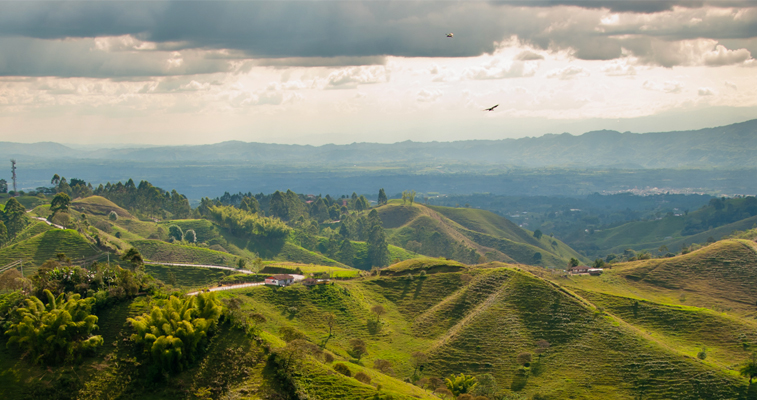Armenia: Queen of the mountains
Tuesday, June 24, 2014

On January 25th, 1999, an earthquake measuring 6.2 on the Richter scale shook Colombia’s coffee-growing region, causing enormous loss of life and severe damage.
Years later, Armenia, the capital of Quindío province, has risen again with renewed vigor and enterprise, earning for itself the title of Miracle City because of its new neighborhoods, hotels, malls, theme parks, road networks and modern public services.
Spending a day in this city, where the mean temperature is 22 °C, is a real delight.
My first stop was at the recently-opened Armenia and Quindío Museum of Art (Maqui), in the former coffee warehouses at the railroad station, an area that in the coming years will be home to a library, conference facilities and handicrafts centers, the Music Institute, and the Municipal Theater. “The trains have gone, but they left us their warehouses so we can express our art”, the museum’s director, María Cristina Mejía, told me. On the museum’s walls hang works by artists from Quindío or who in some
way have connections with the region, such as Henry Villada, a renowned engraver whose works full of flowers, guadua (bamboo) and fruit adorn streets and squares. The city displays them proudly, alongside creations by leading young local artist Viviana Spinosa.
In 1985, Colombian architect Rogelio Salmona built the Quimbaya Culture Center and Gold Museum in his characteristic red-brick style. I made my way there so I could wander through the courtyards adorned with pre-Columbian geometric designs and canals that resound to the tinkling of water, and to enjoy the collection of artifacts produced by the indigenous Quimbayas.
After a quick trip round Bolívar Square, a visit to the cathedral and some shopping on bustling, pedestrianised 14th Street, I sought refuge in Parque de la Vida (Park of Life), a haven of peace in the heart of the city where the forest of Colombian bamboos sighs in the wind. Or as the song by Colombian composer Jorge Villamil says, they cry, because “they too have a soul”.
Quindío and neighboring Caldas and Risaralda provinces together form Colombia’s coffee-growing region, where the ‘Coffee Cultural Landscape’ was recently added to Unesco World Heritage Lists. Coffee is drunk day and night. I savored this aromatic culture at La Morelia farm, very near the provincial capital and with a history dating back more than 50 years. There I was taught the mystique and mystery of the coffee production process, from planting to drinking.
One trip that should not be missed at any cost is to Cocora Valley, in the very heart of the central Andean cordillera and part of Los Nevados National Park. The valley’s name in the local indigenous tongue translates as ‘water star’. Adjectives like majestic, beautiful, overwhelming, sublime and grandiose all passed through my mind… but words cannot really describe what I felt in the middle of this valley when I looked up; the sight simply took my breath away as I gazed, awestruck, at the sheer elegance of the tall wax palms that can grow to heights of up to 60 meters.
Barely a few kilometers away, Salento welcomed me with its brightly-colored doors and balconies, its handicrafts on Calle Real, its legendary coffee-makers, its viewpoint overlooking the river, and a delicious trout with patacones.
Cuyabro cuisine
In addition to traditional cuisine like cazuela cuyabra –a reinterpretation of bandeja paisa served in a pumpkin–, chicken a la carreta or fiambre wrapped in a banana leaf, chef Luz Adriana Martínez has come up with a number of novel dishes using forgotten traditional ingredients such as chontaduro, pipilongo, papa de pobre, chachafruto, pringamosa or coco biche, which she serves in her restaurant in Calarcá, another nearby town.
On the Armenia-Pereira highway, Felipe Palacio cooks Argentinean barbecues and Colombian meats, using the very best cuts. His restaurant, which opened only recently, is called El Secreto de Puerto Madero, and the decoration is crazy. “I buy trash in junk shops and my wife decorates it”, Felipe explains amid barbers’ chairs, old bicycles, statues, and even a 1955 Mercedes Benz, which presides over the dining room.
I don’t know about you, but I have always imagined paradise as being full of flowers, with thousands of trees, fruit and rivers everywhere, magical landscapes, and tiny houses painted in bright colors; everything very green and with a delightful, springtime temperature. Yes, and if we add coffee plants, bamboos and bananas to the picture, we are in Armenia, that corner of Colombia’s coffee-growing region where I would like to stay forever.
You may find more destination articles at www.aviancaenrevista.com.
.jpg)
